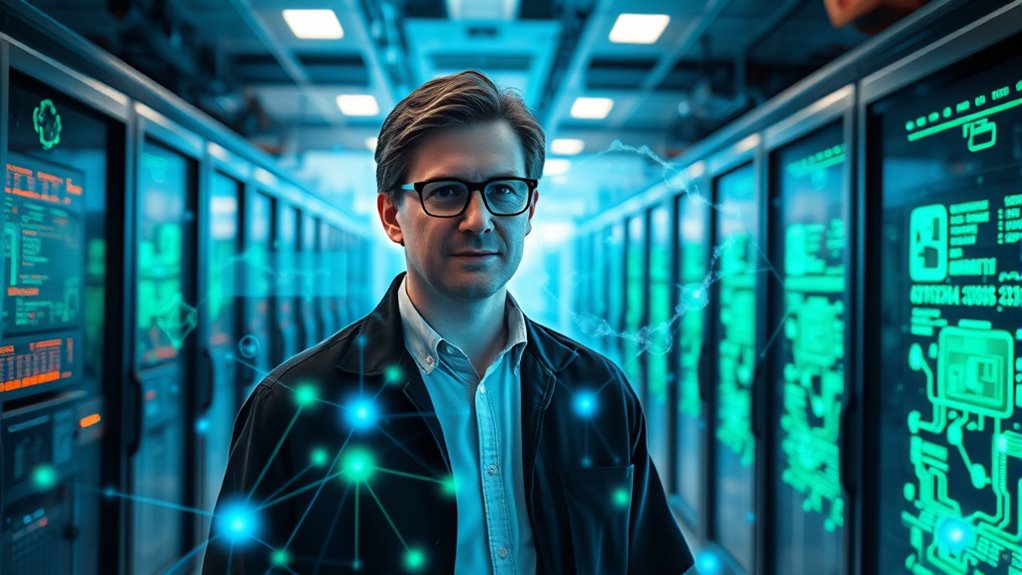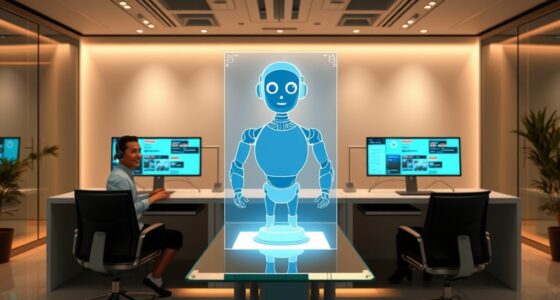Sam Altman is leading a massive push to expand AI infrastructure, building five new data centers and committing over 10 gigawatts of power, which could revolutionize technology and the economy. This project involves partnerships with major firms like Oracle and Nvidia, creating thousands of jobs and boosting regional growth. While the scale raises environmental questions, it showcases a bold vision for AI’s future. Stay with us to uncover how this development might change everything you know about AI.
Key Takeaways
- OpenAI is constructing five new massive data centers over three years, aiming for nearly 7 gigawatts of power capacity.
- The infrastructure project involves a $400-$500 billion investment, with major partners like Oracle and Broadcom.
- The initiative will create over 25,000 jobs locally, boosting economies in Texas, New Mexico, and the Midwest.
- The scale of energy consumption rivals that of three and a half Hoover Dams, raising environmental and sustainability concerns.
- This unprecedented expansion could accelerate AI development and reshape global technology and economic landscapes.

Sam Altman and OpenAI are spearheading an unprecedented expansion of AI infrastructure, announcing five new data centers that will considerably boost capacity over the next three years. This buildout adds to existing projects in Texas, Ohio, and New Mexico, aiming for nearly 7 gigawatts of power—enough to supply over five million U.S. homes. The scale of this effort is staggering, with a projected $400 billion investment, on track to reach $500 billion and a 10-gigawatt commitment by the end of 2025. Each new site will deliver over 5.5 gigawatts, with potential for further expansion, marking what Altman describes as the “largest” infrastructure build of the modern internet era. Building infrastructure at this scale requires immense planning and resources.
Your focus should be on the ambitious partnerships fueling this growth. OpenAI’s Stargate initiative involves key players like Oracle, Nvidia, and SoftBank, with the Oracle partnership alone targeting 4.5 gigawatts and over $300 billion in investments over five years. Broadcom collaborates on developing custom AI accelerators and networking hardware, aiming to produce 10 gigawatts of advanced infrastructure. CoreWeave is also involved, and more site evaluations and partner announcements are expected soon. These collaborations aim to create open, scalable, and energy-efficient AI clusters designed to push the boundaries of what AI can achieve.
As you consider the economic impact, it’s clear this buildout will create more than 25,000 onsite jobs, along with tens of thousands more across supply chains and local communities. The investment is comparable to historic infrastructure projects, promising broad economic benefits, especially in Texas, New Mexico, and the Midwest. Construction, operations, and tech support jobs will surge as local economies experience rapid growth.
On the technical front, Altman envisions producing one gigawatt of new AI infrastructure weekly—a highly ambitious goal, given the technical challenges involved. The focus on custom silicon, advanced networking, and scalable power-efficient clusters aims to liberate next-generation AI breakthroughs. However, the energy demand—equivalent to three and a half Hoover Dams—raises environmental and grid concerns, with public scrutiny about AI’s carbon footprint and electricity costs.
Altman’s rapid expansion signals a pivotal moment in AI’s development, but it also comes with risks—technical, supply chain, and regulatory—that could influence the future trajectory of this transformative industry. [Ensuring sustainable energy sources will be crucial for long-term success.
Frequently Asked Questions
How Will This AI Infrastructure Impact Global Economies?
This AI infrastructure will revolutionize global economies by enabling faster innovation, creating new industries, and boosting productivity. You’ll see increased investment, job opportunities, and economic growth in regions that adopt these technologies early. However, challenges like energy costs, regulatory hurdles, and talent shortages could slow progress. Overall, you’ll witness a shift toward AI-native economies that redefine competitive advantages and reshape the world’s economic landscape.
What Are the Security Measures for This AI Infrastructure?
Security starts with stringent safeguards and strategic steps. You’re protected through OpenAI’s sector-leading Preparedness Framework, which includes regular red team exercises testing threats, and dedicated safety research using substantial compute resources. Collaborations with national security agencies bolster defenses, while advanced fraud countermeasures fight fake identities and deepfakes. Transparency reports promote trust, and continuous improvements guarantee evolving risks are met with innovative, independent, and impactful safety strategies to safeguard the infrastructure.
How Does Altman’s Approach Compare to Competitors?
You see that Altman’s approach focuses on massive infrastructure investments, building multi-billion dollar data centers and forming strategic partnerships like Oracle and Apple. Unlike competitors who prioritize scaling models or enterprise focus, Altman aims for a full-stack, hardware-software integration, signaling a long-term vision of dominant AI infrastructure. This aggressive expansion sets openAI apart, giving you a glimpse into a future where infrastructure leads innovation and industry influence.
What Are the Potential Ethical Concerns?
You might think building powerful AI is all about innovation, but ethical concerns lurk behind every byte. You could misuse personal data, create biased outcomes, or even fuel cybercrime. Trust and privacy are at risk, while dependency might dull critical thinking. Plus, there’s the danger of job loss and environmental strain. So, as you push boundaries, remember: safeguarding morality and human oversight isn’t just an option, it’s essential.
How Can Developers Get Involved With This Project?
You can get involved with the project by integrating OpenAI APIs into your applications, which allows you to leverage advanced AI capabilities. Keep an eye on partnership opportunities, contribute to AI model development, or participate in research and community discussions. Engaging with AI-focused communities and staying updated on new tools and collaborations will also help you stay connected and potentially collaborate on innovative projects within this expanding infrastructure.
Conclusion
As you watch Sam Altman develop this groundbreaking AI infrastructure, remember that Rome wasn’t built in a day. His vision could reshape how we live, work, and connect. While the future may seem uncertain, staying informed and adaptable is key. Just as the greatest innovations often face early challenges, your willingness to embrace change can make all the difference. Keep your eyes on this evolving story—big things are on the horizon, and you’re part of it.








